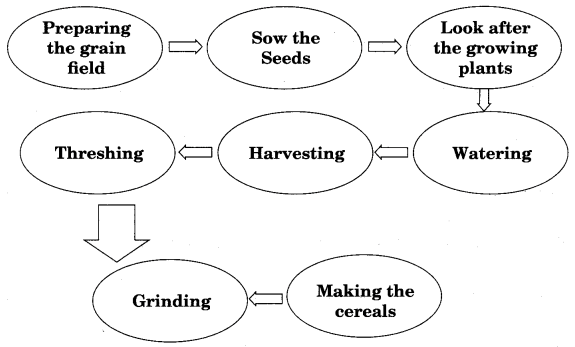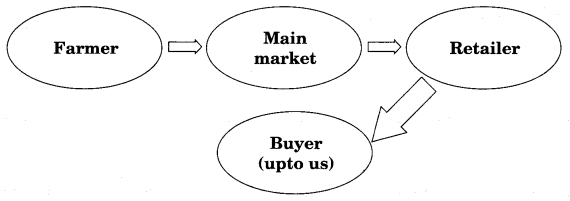NCERT Solutions | Class 6 Social Science History Chapter 3 | From Gathering to Growing Food

CBSE Solutions | Social Science Class 6
Check the below NCERT Solutions for Class 6 Social Science History Chapter 3 From Gathering to Growing Food Pdf free download. NCERT Solutions Class 6 Social Science were prepared based on the latest exam pattern. We have Provided From Gathering to Growing Food Class 6 Social Science NCERT Solutions to help students understand the concept very well.
NCERT | Class 6 Social Science History
| Book: | National Council of Educational Research and Training (NCERT) |
|---|---|
| Board: | Central Board of Secondary Education (CBSE) |
| Class: | 6th |
| Subject: | Social Science History |
| Chapter: | 3 |
| Chapters Name: | From Gathering to Growing Food |
| Medium: | English |
From Gathering to Growing Food | Class 6 Social Science | NCERT Books Solutions
Class 6 History Chapter 3 NCERT Textbook Questions and Answers
Let’s Recall
CBSE Solutions Class 6 History Chapter 3, Question 1.
Why do people who grow crops have to stay in the same place for a long time?CBSE Solutions Class 6 History Chapter 3, Answer:
Gradually, people started to grow the crops. Some of the crops ripened in a month, some in many months whereas some in an year. For the better crops, people felt that they should be protected from birds, animal etc., so that they could grow and ripen the crop safely. Probably, for this purpose people had to stay at the same place for a long time.NCERT Solutions for Class 6 Social Science History Chapter 3, Question 2.
Look at the table on page 25. If Neinuo wanted to eat rice, which are the places she should have visited?NCERT Class 6 Social Science History Chapter 3, Answer:
Students see the table given at page no. 25 of Textbook. As mentioned in the table, rice is mentioned at two sites. Both these sites are presently situated in Uttar Pradesh, these places are:- Koldihwa
- Mahagara.
It is important to note that the given list is just illustrative, not exhaustive and thus there might have been other places also. But on the basis of present table, we can say that she should have visited Koldihwa and Mahagara.
NCERT Solutions Class 6 SST History Chapter 3, Question 3.
Why do archaeologists think that many people who lived in Mehrgarh were hunters to start with and that herding became more important later?NCERT Class 6 SST History Chapter 3, Answer:
Mehrgarh, which is presently situated in Pakistan, is very important site for the archaeologists because at this place they found remains of animal bones at each level/layer of earth. During excavation, bones of wild animals such as the deer and pig have been found from the earliest level.In the later level, they found remains of sheep and goat. And still the later level showed remains of cattle found by the Archaeologists. Thus, we are observing that since the beginning, archaeologists have found remains of animals which expressed that the people of Mehrgarh were hunters to start with and that herding became more important later.
CBSE Social Science Class 6 book Question 4
State whether true or false:
(a) Millets have been found at Hallur.
(b) People in Burzahom lived in rectangular houses.
(c) Chirand is a site in Kashmir.
(d) Jadeite, found in Daojali Hading, many have been brought from China.
NCERT Class 6 History Chapter 3, Answer:
(a) true(b) false
(c) false
(d) true
Let’s Discuss
Class 6 History Chapter 3 questions and answers PDF Question 5.
List three ways in which the lives of farmers and herders would have been different from that of hunter-gatherers.CBSE Class 6 Social Science History Chapter 3, Answer:
Lives of farmers and herders would have been different from that of hunter-gatherers in the following ways:- Hunter-gatherers were food gatherers whereas farmers and herders were producers.
- Hunter-gatherers were not rearing the animals whereas farmers and herders were rearing the animals.
- Hunter-gatherers did not use polished tools whereas farmers and herders used polished and sharp tools alongwith mortars and pestles used for grinding grain and other produces.
- Hunter-gatherers did not use cooked food whereas farmers and herders used cooked food.
CBSE Solutions Class 6 Social Science History Chapter 3, Question 6.
Make a list of all the animals mentioned in the table (page 25). For each one, describe what they may have been used for.CBSE Class 6 SST History Chapter 3, Answer:
Students carefully see the table given on Textbook at page no. 25. We found that sheep, goat, dog, buffalo, ox and pig have been mentioned in the table. These animals might have been used for:- Sheep: for meat, milk and wool.
- Goat: for meat and milk.
- Dog: used for hunting and watching.
- Buffalo: for drawing cart, milk and meat.
- Ox: for drawing cart, chariot and ploughing.
Let’s Do
NCERT Solutions Class 6 Social Science History Chapter 3, Question 7.
List the cereals that you eat.CBSE Class 6 History Chapter 3, Answer:
Name of the cereals which we eat are:- Rice
- Barley
- Maize
- Wheat
- Black and white gram
- Peas
- Pulses
- Lentil
SST Class 6 NCERT book Question 8.
Do you grow the cereals you have listed in answer no. 7? If yes, draw a chart to show the stages in growing them. If not, draw a chart to show how these cereals reach you from the farmers who grow them.NCERT Solutions for Class 6 Social Science History Chapter 3, Answer:
Yes, we can grow the cereals in the field of a village. Growing stages can be drawn as follows:
Suppose, we live in a big city like Delhi. We do not have fields for growing the grains. We will take this from our nearest shopkeeper. To obtain the cereals, the chain system may be as follows:

NCERT Class 6 Social Science
Class 6 Social Science Chapters | Social Science Class 6 Chapter 3
NCERT Solutions for Class 6 Social Science Geography
NCERT Solutions for Class 6 Social Science Geography: The Earth: Our Habitat
-
NCERT Solutions For Class 6 Social Science Geography Chapter 1 The Earth in the Solar System
NCERT Solutions For Class 6 Social Science Geography Chapter 2 Globe Latitudes and Longitudes
NCERT Solutions For Class 6 Social Science Geography Chapter 3 Motions of the Earth
NCERT Solutions For Class 6 Social Science Geography Chapter 4 Maps
NCERT Solutions For Class 6 Social Science Geography Chapter 5 Major Domains of the Earth
NCERT Solutions For Class 6 Social Science Geography Chapter 6 Major Landforms of the Earth
NCERT Solutions For Class 6 Social Science Geography Chapter 7 Our Country India
NCERT Solutions For Class 6 Social Science Geography Chapter 8 India Climate Vegetation and Wildlife
NCERT Solutions for Class 6 Social Science History
NCERT Solutions for Class 6 Social Science History: Our Pasts – I
-
NCERT Solutions For Class 6 Social Science History Chapter 1 What, Where, How and When?
NCERT Solutions For Class 6 Social Science History Chapter 2 On The Trial of the Earliest People
NCERT Solutions For Class 6 Social Science History Chapter 3 From Gathering to Growing Food
NCERT Solutions For Class 6 Social Science History Chapter 4 In the Earliest Cities
NCERT Solutions For Class 6 Social Science History Chapter 5 What Books and Burials Tell Us
NCERT Solutions For Class 6 Social Science History Chapter 6 Kingdoms, Kings and an Early Republic
NCERT Solutions For Class 6 Social Science History Chapter 7 New Questions and Ideas
NCERT Solutions For Class 6 Social Science History Chapter 8 Ashoka, The Emperor Who Gave Up War
NCERT Solutions For Class 6 Social Science History Chapter 9 Vital Villages, Thriving Towns
NCERT Solutions For Class 6 Social Science History Chapter 10 Traders, Kings and Pilgrims
NCERT Solutions For Class 6 Social Science History Chapter 11 New Empires and Kingdoms
NCERT Solutions For Class 6 Social Science History Chapter 12 Buildings, Paintings, and Books
NCERT Solutions for Class 6 Social Science Civics
NCERT Solutions for Class 6 Social Science Civics: Social and Political Life – I
-
NCERT Solutions For Class 6 Social Science Civics Chapter 1 Understanding Diversity
NCERT Solutions For Class 6 Social Science Civics Chapter 2 Diversity and Discrimination
NCERT Solutions For Class 6 Social Science Civics Chapter 3 What is Government
NCERT Solutions For Class 6 Social Science Civics Chapter 4 Key Elements of a Democratic Government
NCERT Solutions For Class 6 Social Science Civics Chapter 5 Panchayati raj
NCERT Solutions For Class 6 Social Science Civics Chapter 6 Rural Administration
NCERT Solutions For Class 6 Social Science Civics Chapter 7 Urban Administration
NCERT Solutions For Class 6 Social Science Civics Chapter 8 Rural Livelihoods
NCERT Solutions For Class 6 Social Science Civics Chapter 9 Urban Livelihoods
NCERT Solutions for Class 6 to 8
| NCERT Solutions for Class 12 All Subjects | NCERT Solutions for Class 10 All Subjects |
| NCERT Solutions for Class 11 All Subjects | NCERT Solutions for Class 9 All Subjects |

Post a Comment
इस पेज / वेबसाइट की त्रुटियों / गलतियों को यहाँ दर्ज कीजिये
(Errors/mistakes on this page/website enter here)